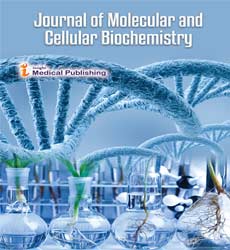Growth Factor and Its Use
Stephen Alfredo*
Department of Biochemistry, University of Ambo, Ambo, Ethiopia
- *Corresponding Author:
- Stephen Alfredo
Department of Biochemistry,
University of Ambo,
Ambo,
Ethiopia
E-mail: alfredo@ju.edu.et
Received Date: November 5, 2021; Accepted Date: November 19, 2021; Published Date: November 26, 2021
Citation: Alferdo S (2021) Growth Factor and Its Use. J Mol Cell Biochem Vol. 5 No.5:e008
Editorial Note
Any set of proteins that stimulates the growth of specific tissues is referred as a growth factor. Growth factors are found in a wide variety of animals, including insects, amphibians, humans, and plants, and they serve a crucial role in encouraging cell development and cell division. A growth factor can be defined as a physiologically active substance that is secreted and can influence cell growth. Growth factor term has been broadened to include secreted substances that promote or inhibit mitosis or have an effect on cellular differentiation. Growth factors can act on certain cell surface receptors, which then send growth signals to other intracellular components, resulting in altered gene expression. Growth factors can stimulate cells by endocrine, paracrine, or autocrine processes. Growth factors often operate locally due to their short half-lives and slow dispersion in intercellular gaps. The signal transduction in growth factors is often begun by attaching to the receptors on the surface of target cells. A growth factor has a specific instruction to a certain group of cells and is determined by the type of receptors, the amount of target cells, and the intracellular signal transduction that occurs after factor binds to the substrate. Furthermore, external factors such as a growth factor's ability to adhere to Extracellular Matrices (ECM), ECM degradation, and growth factor concentration have an impacts on a target cell's ultimate response to a specific growth factor. Growth factors secrete soluble factors which can be identified in cell culture conditioned medium. Membraneanchored growth factors are present, which attach to the membrane of the cell and start functioning accordingly. Growth factors can be autocrine, paracrine, juxtacrine, or retrocrine. EGF, FGF, NGF, PDGF, VEGF, IGF, GMCSF, GCSF, TGF, Erythropoietin, TPO, BMP, HGF, GDF, Neurotrophins, MSF, SGF, GDF are examples of growth factors. Growth factors play an important role in cell differentiation and are required for a functional cell cycle, making them crucial components of animal life since birth till death. Growth factors mediate foetal development, play a role in tissue maintenance and repair, drive blood cell creation, and are involved in malignant processes. Growth factors can help in generating more stem cells.
Uses in wound healing and cancer
Wound healing is a normal, multiphase physiological process. The important three stages of the Growth factors in wound healing are as follows: (1) The inflammatory phase, (2) The prolif- -erative phase, and (3) The remodelling phase.
Platelets are the most important cell type during the inflammatory phase because they produce Platelet - Derived Derived Growth Factor (PDGF) and TGF-beta, two growth factors that recruit macrophages and neutrophils. Neutrophils are white blood cells that can eliminate bacteria at the wound site, preventing sepsis. Macrophages release growth factors that are fibroblast and plays an important role in the primary or proliferative phase of wound healing and the growth factor help to recover white blood cell and fight against all foreign particles. In cancer treatment, as chemotherapy kill both leukemic and healthy white blood cells, there is a danger of infection while white cell count is low. Neutropenia is a condition characterized by a low level of white blood cells. The growth factors aid in the recovery of white blood cell counts, they had no effect on the number of infections.
Open Access Journals
- Aquaculture & Veterinary Science
- Chemistry & Chemical Sciences
- Clinical Sciences
- Engineering
- General Science
- Genetics & Molecular Biology
- Health Care & Nursing
- Immunology & Microbiology
- Materials Science
- Mathematics & Physics
- Medical Sciences
- Neurology & Psychiatry
- Oncology & Cancer Science
- Pharmaceutical Sciences
